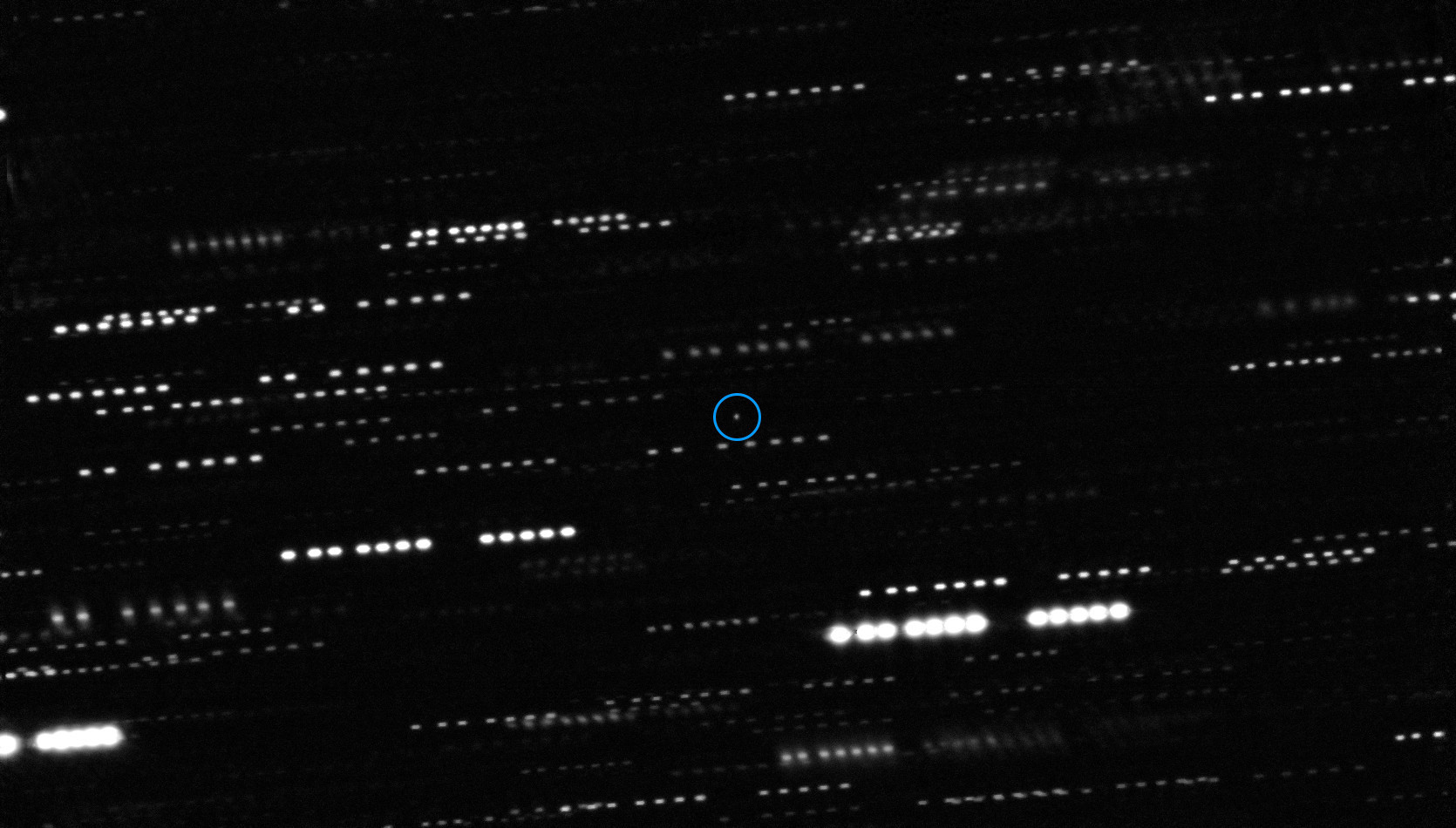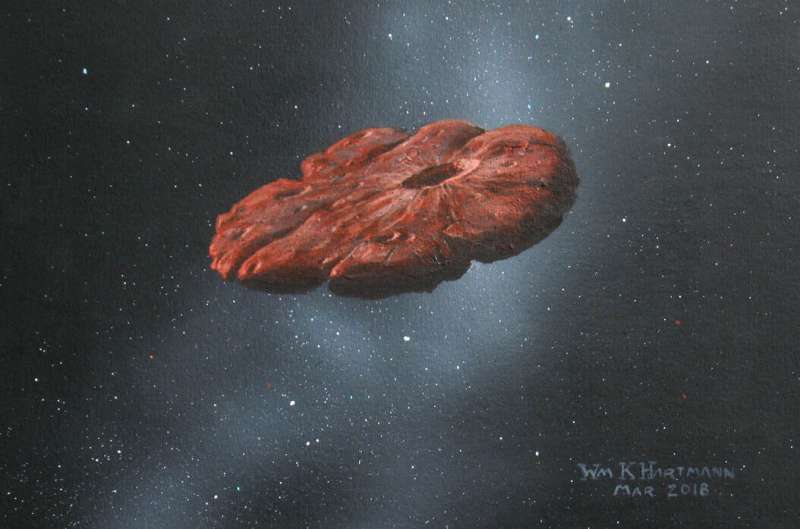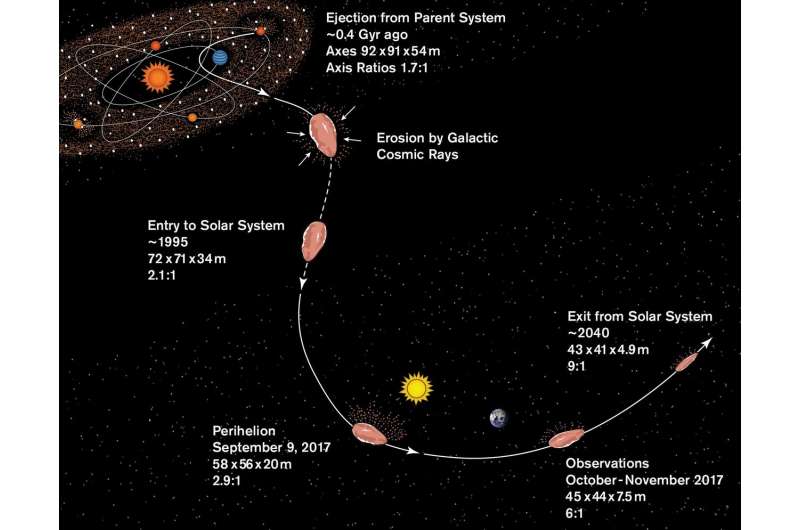The first known interstellar object to visit our solar system.
‘Oumuamua Overview
‘Oumuamua is the first confirmed object from another star to visit our solar system. This interstellar interloper appears to be a rocky, cigar-shaped object with a somewhat reddish hue.
The object was named ‘Oumuamua by its discoverers. It means «a messenger from afar arriving first» in Hawaiian.
‘Oumuamua is up to one-quarter mile (400 meters) long and highly-elongated – perhaps 10 times as long as it is wide. That aspect ratio is greater than that of any asteroid or comet observed in our solar system to date. While its elongated shape is quite surprising, and unlike objects seen in our solar system, it may provide new clues into how other solar systems formed.
The observations suggest this unusual object had been wandering through the Milky Way, unattached to any star system, for hundreds of millions of years before its chance encounter with our star system.
Immediately after its discovery, telescopes around the world, including ESO’s Very Large Telescope in Chile, were called into action to measure the object’s orbit, brightness and color. Urgency for viewing from ground-based telescopes was vital to get the best data.
Combining the images from the FORS instrument on the ESO telescope using four different filters with those of other large telescopes, a team of astronomers led by Karen Meech of the Institute for Astronomy in Hawaii found that ‘Oumuamua varies in brightness by a factor of 10 as it spins on its axis every 7.3 hours. No known asteroid or comet from our solar system varies so widely in brightness, with such a large ratio between length and width. The most elongated objects we have seen to date are no more than three times longer than they are wide.

The interstellar object ‘Oumuamua is at the center of this image and circled in blue. It is surrounded by the trails of faint stars that are smeared as the telescopes tracked the moving comet.
ESO/K. Meech et al.
“This unusually big variation in brightness means that the object is highly elongated: about ten times as long as it is wide, with a complex, convoluted shape,” said Meech. “We also found that it had a reddish color, similar to objects in the outer solar system, and confirmed that it is completely inert, without the faintest hint of dust around it.”
These properties suggest that ‘Oumuamua is dense, composed of rock and possibly metals, has no water or ice, and that its surface was reddened due to the effects of irradiation from cosmic rays over hundreds of millions of years.
A few large ground-based telescopes continued to track the fading object as it receded from our planet. Two of NASA’s space telescopes (Hubble and Spitzer) tracked the object traveling about 85,700 miles per hour (38.3 kilometers per second) relative to the Sun. Its outbound path is about 20 degrees above the plane of planets that orbit the Sun. The object passed Mars’s orbit around Nov. 1 and will pass Jupiter’s orbit in May of 2018. It will travel beyond Saturn’s orbit in January 2019; as it leaves our solar system, ‘Oumuamua will head for the constellation Pegasus.
Preliminary orbital calculations suggest that the object came from the approximate direction of the bright star Vega, in the northern constellation of Lyra. However, it took so long for the interstellar object to make the journey―even at the speed of about 59,000 miles per hour (26.4 kilometers per second)―that Vega was not near that position when the ‘Oumuamua was there about 300,000 years ago.
Astronomers estimate that an interstellar object similar to ‘Oumuamua passes through the inner solar system about once per year, but they are faint and hard to spot and have been missed until now. It is only recently that survey telescopes, such as Pan-STARRS1, are powerful enough to have a chance to discover them.
“What a fascinating discovery this is!” said Paul Chodas, manager of the Center for Near-Earth Object Studies at NASA’s Jet Propulsion Laboratory, Pasadena, California. “It’s a strange visitor from a faraway star system, shaped like nothing we’ve ever seen in our own solar system neighborhood.”
Discovery
The first known interstellar object to visit our solar system, 1I/2017 U1 ‘Oumuamua, was discovered Oct. 19, 2017 by the University of Hawaii’s Pan-STARRS1 telescope, funded by NASA’s Near-Earth Object Observations (NEOO) Program, which finds and tracks asteroids and comets in Earth’s neighborhood. While originally classified as a comet, observations revealed no signs of cometary activity after it slingshotted past the Sun on Sept. 9, 2017 at a blistering speed of 196,000 miles per hour (87.3 kilometers per second). It was briefly classified as an asteroid until new measurements found it was accelerating slightly, a sign it behaves more like a comet.
How ‘Oumuamua Got its Name
The object was officially named 1I/2017 U1 by the International Astronomical Union (IAU), which is responsible for granting official names to bodies in the solar system and beyond. In addition to the technical name, the Pan-STARRS team dubbed it ‘Oumuamua (pronounced oh MOO-uh MOO-uh), which is Hawaiian for “a messenger from afar arriving first.”
Scientists determine the origin of extra-solar object ‘Oumuamua

In 2017, the first interstellar object from beyond our solar system was discovered via the Pan-STARRS astronomical observatory in Hawaii. It was named ‘Oumuamua, meaning «scout» or «messenger» in Hawaiian. The object was like a comet, but with features that were just odd enough to defy classification.
Two Arizona State University astrophysicists, Steven Desch and Alan Jackson of the School of Earth and Space Exploration, set out to explain the odd features of ‘Oumuamua and have determined that it is likely a piece of a Pluto-like planet from another solar system. Their findings have been recently published in a pair of papers in the AGU Journal of Geophysical Research: Planets.
«In many ways ‘Oumuamua resembled a comet, but it was peculiar enough in several ways that mystery surrounded its nature, and speculation ran rampant about what it was,» said Desch, who is a professor in the School of Earth and Space Exploration.
From observations of the object, Desch and Jackson determined several characteristics of the object that differed from what would be expected from a comet.
In terms of speed, the object entered the solar system at a velocity a bit lower than would be expected, indicating that it had not been traveling in interstellar space for more than a billion years or so. In terms of size, its pancake shape was also more flattened than any other known solar system object.
They also observed that while the object acquired a slight push away from the sun (a «rocket effect» common in comets as sunlight vaporizes the ices they are made of), the push was stronger than could be accounted for. Finally, the object lacked a detectable escaping gas, which is usually depicted visibly by a comet’s tail. In all, the object was very much like a comet, but unlike any comet that had ever been observed in the solar system.
Desch and Jackson then hypothesized that the object was made of different ices and they calculated how quickly these ices would sublimate (passing from a solid to a gas) as ‘Oumuamua passed by the sun. From there, they calculated the rocket effect, the object’s mass and shape, and the reflectivity of the ices.
«That was an exciting moment for us,» Desch said. «We realized that a chunk of ice would be much more reflective than people were assuming, which meant it could be smaller. The same rocket effect would then give ‘Oumuamua a bigger push, bigger than comets usually experience.»
Desch and Jackson found one ice in particular—solid nitrogen—that provided an exact match to all the object’s features simultaneously. And since solid nitrogen ice can be seen on the surface of Pluto, it is possible that a cometlike object could be made of the same material.
«We knew we had hit on the right idea when we completed the calculation for what albedo (how reflective the body is) would make the motion of ‘Oumuamua match the observations,» said Jackson, who is a research scientist and an Exploration Fellow at ASU. «That value came out as being the same as we observe on the surface of Pluto or Triton, bodies covered in nitrogen ice.»
They then calculated the rate at which chunks of solid nitrogen ice would have been knocked off the surfaces of Pluto and similar bodies early in our solar system’s history. And they calculated the probability that chunks of solid nitrogen ice from other solar systems would reach ours.
«It was likely knocked off the surface by an impact about half a billion years ago and thrown out of its parent system,» Jackson said. «Being made of frozen nitrogen also explains the unusual shape of ‘Oumuamua. As the outer layers of nitrogen ice evaporated, the shape of the body would have become progressively more flattened, just like a bar of soap does as the outer layers get rubbed off through use.»
Could ‘Oumuamua have been alien technology?
Although ‘Oumuamua’s cometlike nature was quickly recognized, the inability to immediately explain it in detail led to speculation that it is a piece of alien technology, as in the recently published book «Extraterrestrial: The First Signs of Intelligent Life Beyond Earth» by Avi Loeb of Harvard University.

This has sparked a public debate about the scientific method and the responsibility of scientists not to jump to unwarranted conclusions.
«Everybody is interested in aliens, and it was inevitable that this first object outside the solar system would make people think of aliens,» Desch said. «But it’s important in science not to jump to conclusions. It took two or three years to figure out a natural explanation—a chunk of nitrogen ice—that matches everything we know about ‘Oumuamua. That’s not that long in science, and far too soon to say we had exhausted all natural explanations.»
Although there is no evidence that it is alien technology, as a fragment of a Pluto-like planet, ‘Oumuamua has provided scientists with a special opportunity to look at extrasolar systems in a way that they have not been able to before. As more objects like ‘Oumuamua are found and studied, scientists can continue to expand our understanding of what other planetary systems are like and the ways in which they are similar to, or different from, our own solar system.
«This research is exciting in that we’ve probably resolved the mystery of what ‘Oumuamua is and we can reasonably identify it as a chunk of an ‘exo-Pluto,’ a Pluto-like planet in another solar system,» Desch said. «Until now, we’ve had no way to know if other solar systems have Pluto-like planets, but now we have seen a chunk of one pass by Earth.»
Desch and Jackson hope that future telescopes, like those at the Vera Rubin Observatory/Large Synoptic Survey Telescope in Chile, which will be able to survey the entire southern sky on a regular basis, will be able to start finding even more interstellar objects that they and other scientists can use to further test their ideas.
«It’s hoped that in a decade or so we can acquire statistics on what sorts of objects pass through the solar system, and if nitrogen ice chunks are rare or as common as we’ve calculated,» Jackson said. «Either way, we should be able to learn a lot about other solar systems, and whether they underwent the same sorts of collisional histories that ours did.»
More information: Alan P. Jackson et al. 1I/’Oumuamua as an N 2 ice fragment of an exo‐Pluto surface: I. Size and Compositional Constraints, Journal of Geophysical Research: Planets (2021). DOI: 10.1029/2020JE006706
S. J Desch et al. 1I/’Oumuamua as an N 2 ice fragment of an exo‐pluto surface II: Generation of N 2 ice fragments and the origin of ‘Oumuamua, Journal of Geophysical Research: Planets (2021). DOI: 10.1029/2020JE006807
Provided by Arizona State University



